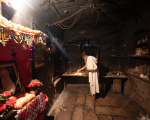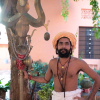Dadu Dayal was a 16th-century sant who founded the Dadu panth, a religious tradition, today based largely in Rajasthan. A biographical account of his life is given in the Dadu Janamlila, composed shortly after his death in 1603 by a disciple named Jan Gopal. According to this, Dadu was born in Ahmedabad to a Muslim dhuniya (cotton-carder), found enlightenment at an early age helped by an old master (Baba Buddha), and travelled to various parts of present-day Rajasthan spreading his message of love and devotion and attracting a large body of followers.
Used to refer to holy men in north India in a generic way, the word Sant carries two more particular connotations. The first is associated with members of the Warkari panth in Maharashtra, while the other is associated with the bhakti saints of North India in the lineage of Kabir, Nanak, etc. It is in this latter group that Dadu Dayal is placed, as a part of a larger tradition of self-realized spiritual masters who appeared between 13th to 17th century and contributed to (what many scholars understand to be) a reformatory wave in Hinduism. The Sants were largely non-sectarian figures who rejected elaborate ritualism, the dominance of priests and caste based discrimination in religious worship and promoted a path of inward experience and direct relationship with God. Consequently, they attracted followers from all sections of the society, especially the dispossessed. The paths that they prescribed have been classified as sagun bhakti i.e. devotion to a human form of God ‘with qualities’ and nirgun bhakti i.e. devotion to a formless divine being who is ‘without qualities’.
While the Dadu panth started developing in Dadu’s lifetime itself, much of the organizational work was done by his disciples after his death. As per tradition, Dadu left 152 disciples and 52 of them started Dadu centers or dwaras (literally, doors) in different parts of Rajasthan. Several of these dwaras are still flourishing. Today, the five most important sites associated with the Dadu panth also known as the panchteeraths or Dadu dhams, are Kardala, Sambhar, Amer, Naraina and Bhairana. These sites are important, amongst other reasons, for the large period of time Dadu is supposed to have spent here in between his wanderings or ramat. Bhairana is significant as the site where Dadu is believed to have taken samadhi and Naraina, perhaps the most important of these sites, is the primary seat of the Dadupanthis (followers of the Dadu panth) with the leader of the panth residing there. The Naraina dham is also the site of a large annual festival that is celebrated around Dadu’s birth anniversary in Februry-March each year.
A large number of Sants composed vernacular devotional poetry, which was spread to the masses largely through oral transmission. In the case of the Dadu panth however, in addition to a strong oral culture, writing as an activity was popular from the very beginning. In addition to Dadu himself, many of his disciples were poets in their own right and contributed to the vast body of Dadupanthi literature that exists today. The Dadu Vani (literally, the ‘speech of Dadu’) is a collection of his verses and other utterances, and has today become the primary text and object of worship for the panth.
In September 2019, Sahapedia visited the ashram of a Dadupanthi ascetic in Aandhi and the Dadu dhams at Naraina, Sambhar, Bhairana and Amer interviewing the current leader of the panth, mahants (head priests) and lay devotees; recording recitations of the Dadu Vani and documenting these sites.
References
Horstmann, M. ‘The Flow of Grace: Food and Feast in the Hagiography and History of the Dadupanth’. Zeitschrift der Deutschen Morgenländischen Gesellschaft 150 (2000): 513–580.
———. ‘Dadupanthi Anthologies of the Eighteenth and Centuries’. In Bhakti in Current Research, 2001–2003, edited by M. Horstmann. New Delhi: Manohar, 2006.
Grewal, J.S. and Indu Banga, ‘Dadu and the Dadu-Panthis’, in Religious Movements and Institutions in Medieval India. Volume 7, Part 2 of History of Science, Philosophy and Culture in Indian Civilization, edited by J.S. Grewal, 444–46. New Delhi: Oxford University Press, 2006.
Callewaert, Winand M. ‘Sants’. Volume 3 of Brill’s Encyclopedia of Hinduism, edited by Knut A. Jacobsen, Helene Basu, Angelika Malinar and Vasudha Narayanan, 532–45. Leiden: Brill, 2014.
Sahapedia is grateful to Bajaj Autos Pvt. Ltd. for the grant that made possible the documentation for this photo essay.

















